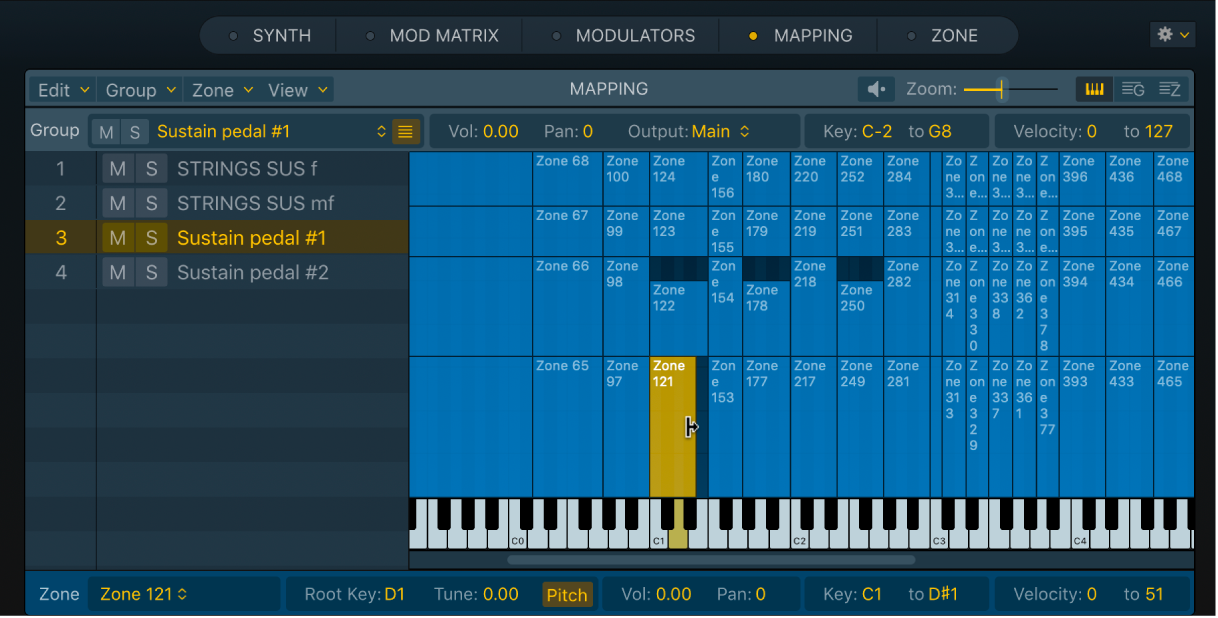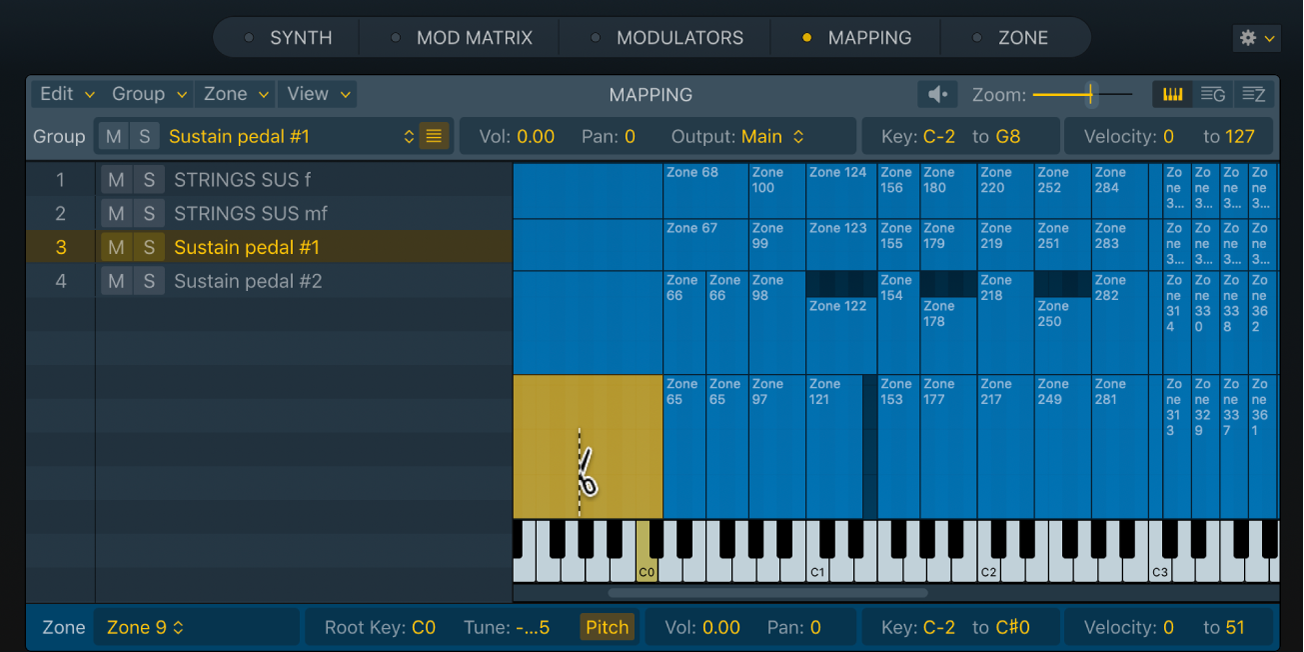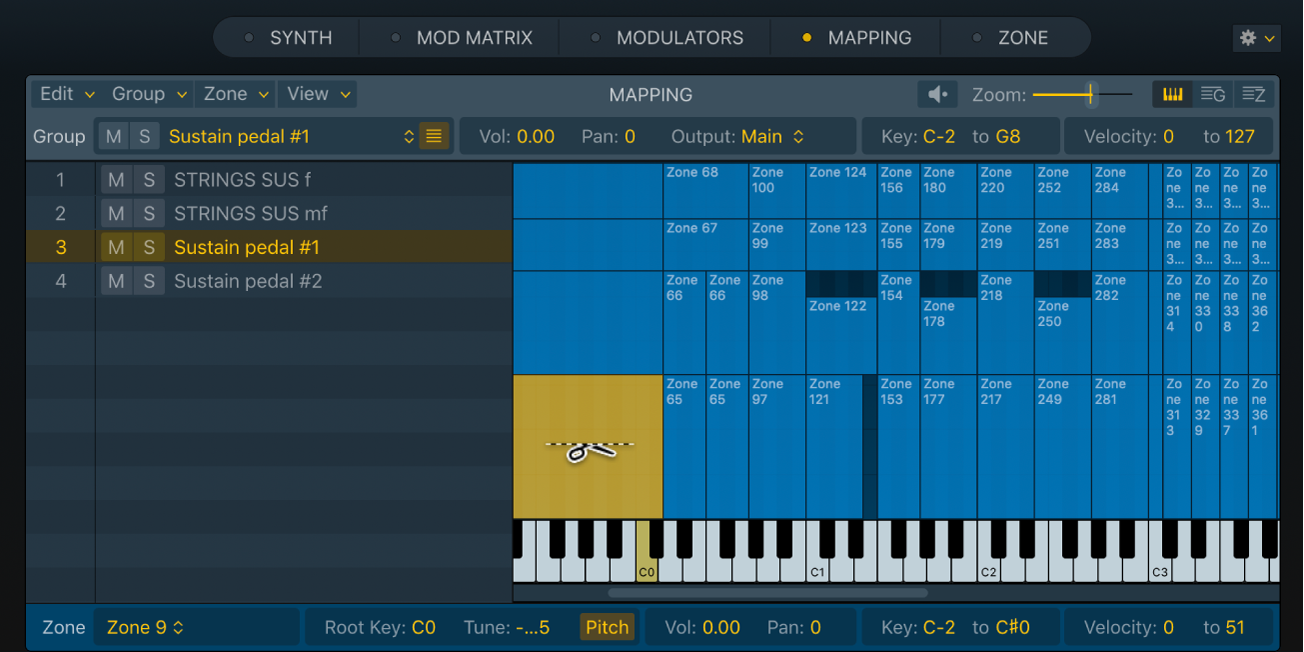MainStage User Guide
- Welcome
-
- Overview of Edit mode
-
- Select patches and sets in the Patch List
- Copy, paste, and delete patches
- Reorder and move patches in the Patch List
- Add and rename patches
- Create a patch from several patches
-
- Overview of the Patch Settings Inspector
- Select patch settings in the Patch Library
- Set the time signature for patches
- Change the tempo when you select a patch
- Set program change and bank numbers
- Defer patch changes
- Instantly silence the previous patch
- Change patch icons
- Transpose the pitch of incoming notes for a patch
- Change the tuning for a patch
- Add text notes to a patch
-
- Overview of channel strips
- Add a channel strip
- Change a channel strip setting
- Configure channel strip components
- Show signal flow channel strips
- Hide the metronome channel strip
- Create an alias of a channel strip
- Add a patch bus
- Set channel strip pan or balance positions
- Set channel strip volume levels
- Mute and solo channel strips
- Use multiple instrument outputs
- Use external MIDI instruments
- Reorganize channel strips
- Delete channel strips
-
- Overview of the Channel Strip Inspector
- Choose channel strip settings
- Rename channel strips
- Change channel strip colors
- Change channel strip icons
- Use feedback protection with channel strips
- Set keyboard input for a software instrument channel strip
- Transpose individual software instruments
- Filter MIDI messages
- Scale channel strip velocity
- Set channel strips to ignore Hermode tuning
- Override concert- and set-level key ranges
- Add text notes to a channel strip in the Channel Strip Inspector
- Route audio via send effects
-
- Screen Control Inspector overview
- Replace parameter labels
- Choose custom colors for screen controls
- Change background or grouped screen control appearance
- Set screen controls to show the hardware value
- Set parameter change behavior for screen controls
- Set hardware matching behavior for screen controls
- Reset and compare changes to a patch
- Override concert- and set-level mappings
-
- Overview of mapping screen controls
- Map to channel strip and plug-in parameters
- Map screen controls to actions
- Map a screen control to multiple parameters
- Use screen controls to display PDF document pages
- Edit the saved value for a mapped parameter
- Set drum pads or buttons to use note velocity
- Map screen controls to all channel strips in a patch
- Undo screen control parameter mappings
- Remove screen control mappings
- Work with graphs
- Create controller transforms
- Share patches and sets between concerts
- Record the audio output of a concert
-
- Overview of concerts
- Create a concert
- Open and close concerts
- Save concerts
- How saving affects parameter values
- Clean up concerts
- Consolidate assets in a concert
- Rename the current concert
-
- Overview of the Concert Settings Inspector
- Set MIDI Routing to channel strips
- Transpose incoming note pitch for a concert
- Define the program change message source
- Send unused program changes to channel strips
- Set the time signature for a concert
- Change the tuning for a concert
- Set the pan law for a concert
- Add text notes to a concert
- Control the metronome
- Silence MIDI notes
- Mute audio output
-
- Layout mode overview
-
- Screen control parameter editing overview
- Lift and stamp screen control parameters
- Reset screen control parameters
- Common screen control parameters
- Keyboard screen control parameters
- MIDI activity screen control parameters
- Drum pad screen control parameters
- Waveform screen control parameters
- Selector screen control parameters
- Text screen control parameters
- Background screen control parameters
- How MainStage passes through MIDI messages
- Export and import layouts
- Change the aspect ratio of a layout
-
- Before performing live
- Use Perform mode
- Screen controls in performance
- Tempo changes during performance
- Tips for performing with keyboard controllers
- Tips for performing with guitars and other instruments
- Tune guitars and other instruments with the Tuner
- The Playback plug-in in performance
- Record your performances
- After the performance
- Tips for complex hardware setups
-
- Overview of keyboard shortcuts and command sets
-
- Concerts and layouts keyboard shortcuts
- Patches and sets (Edit mode) keyboard shortcuts
- Editing keyboard shortcuts
- Actions keyboard shortcuts
- Parameter mapping (Edit mode) keyboard shortcuts
- Channel strips (Edit mode) keyboard shortcuts
- Screen controls (Layout mode) keyboard shortcuts
- Perform in Full Screen keyboard shortcuts
- Window and view keyboard shortcuts
- Help and support keyboard shortcuts
-
-
- Use MIDI plug-ins
-
- Arpeggiator overview
- Arpeggiator control parameters
- Note order parameters overview
- Note order variations
- Note order inversions
- Arpeggiator pattern parameters overview
- Use Live mode
- Use Grid mode
- Arpeggiator options parameters
- Arpeggiator keyboard parameters
- Use keyboard parameters
- Assign controllers
- Modifier controls
- Note Repeater controls
- Randomizer controls
-
- Use Scripter
- Use the Script Editor
- Scripter API overview
- MIDI processing functions overview
- HandleMIDI function
- ProcessMIDI function
- GetParameter function
- SetParameter function
- ParameterChanged function
- Reset function
- JavaScript objects overview
- Use the JavaScript Event object
- Use the JavaScript TimingInfo object
- Use the Trace object
- Use the MIDI event beatPos property
- Use the JavaScript MIDI object
- Create Scripter controls
- Transposer controls
-
-
- Alchemy overview
- Alchemy interface overview
- Alchemy Name bar
- Alchemy file locations
-
- Alchemy source overview
- Source master controls
- Import browser
- Source subpage controls
- Source filter controls
- Source filter use tips
- Source elements overview
- Additive element controls
- Additive element effects
- Spectral element controls
- Spectral element effects
- Pitch correction controls
- Formant filter controls
- Granular element controls
- Sampler element controls
- VA element controls
- Wide unison mode
- Source modulations
- Morph controls
- Alchemy master voice section
- Alchemy Extended parameters
-
- Playback plug-in overview
- Add a Playback plug-in
- Playback interface
- Use the Playback waveform display
- Playback transport and function buttons
- Playback information display
- Playback Sync, Snap To, and Play From parameters
- Use the Playback group functions
- Use the Playback Action menu and File field
- Use markers with the Playback plug-in
-
- Sample Alchemy overview
- Interface overview
- Add source material
- Edit mode
- Play modes
- Source overview
- Synthesis modes
- Granular controls
- Additive effects
- Additive effect controls
- Spectral effect
- Spectral effect controls
- Filter module
- Lowpass, bandpass, and highpass filters
- Comb PM filter
- Downsampler filter
- FM filter
- Envelope generators
- Mod Matrix
- Modulation routing
- Motion mode
- Trim mode
- More menu
-
- Sculpture overview
- Sculpture interface
- Global parameters
- Amplitude envelope parameters
- Use the Waveshaper
- Filter parameters
- Output parameters
- Define MIDI controllers
- Extended parameters
-
- Studio Piano
- Copyright

Graphically edit zones and groups in Sampler in MainStage
You can edit zone and group parameters numerically in the Mapping pane Zone view and Group view. You can also graphically edit a number of zone and group parameters in the Key Mapping Editor and the Zone pane.
Within each group mapping area (notes and velocities), zones can’t overlap. When you force an overlap by dragging zones one above the other within the same group, the Key Mapping Editor automatically cuts zones in order to make space for other zones. This allows you to add zones or delete mapped areas without having to edit all affected zones directly. You can protect either the selected or unselected zones when dragging zones.

Move one or more zones by dragging
In the MainStage Sampler Key Mapping Editor:
Drag the zone to the target Key Mapping Editor position.
Shift-click or drag (from an empty area outside any zone) to select multiple zones, and drag them to the target Key Mapping Editor position.
Move one or more selected zones to the left or right with a key command
In the MainStage Sampler Key Mapping Editor:
Select one or more zones, then use one of the following key commands:
Shift Selected Zone(s)/Group(s) Left: Option-Left Arrow key
Shift Selected Zone(s)/Group(s) Right: Option-Right Arrow key
Restrict zone dragging to one direction
In the MainStage Sampler Key Mapping Editor:
Press and hold the Command key to restrict movement to the initial horizontal or vertical drag direction.
Change the root key when moving a zone
The default behavior when dragging a zone to a key in the Key Mapping Editor is set with the “Always Move Root Key with Zone” option in the Zone menu.
In the MainStage Sampler Key Mapping Editor do one of the following:
Drag the zone. If the “Always Move Root Key with Zone” option in the Zone menu is not active, press and hold Option-Command while dragging the zone.
Select a zone, then use one of the following key commands:
Shift Selected Zone(s)/Group(s) Left (Zones incl. Root Key): Option-Shift-Left Arrow key
Shift Selected Zone(s)/Group(s) Right (Zones incl. Root Key: Option-Shift-Right Arrow key
Change the start or end note of a zone
In the MainStage Sampler Key Mapping Editor:
Drag the start or end point of the zone or group to the target position.

Change the velocity range of a zone
In the MainStage Sampler Key Mapping Editor:
Move the pointer to the top or bottom of a zone (the pointer changes to the resize icon).
Shift-click to select multiple zones if you want to simultaneously adjust their velocity range.

Drag the resize icon upward to raise the value, or downward to reduce the value.
If you drag over (overlap) another zone assigned to the same key range in the group, its velocity range will be resized. If you want to layer zones, use different groups.
Divide a zone vertically
In the MainStage Sampler Key Mapping Editor:
Select a zone.
Press and hold Command-Option to display a vertical cut icon at the pointer position, then click the zone.
The zone is divided vertically and a new zone is created. Each zone can be independently edited.

Divide a zone horizontally
In the MainStage Sampler Key Mapping Editor:
Select a zone.
Press and hold Shift-Option to display a horizontal cut icon at the pointer position, then click the zone.
The zone is divided horizontally and a new zone is created. Each zone can be independently edited.
